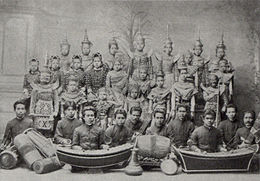Aside from the Thai, ethnic minorities such as the Lao, Lawa, Hmong, Akha, Khmer, Lisu, Karen and Lahu peoples have retained traditional musical forms.
Contents |
Classical music
 |
Wax cylinder recording of "Kham Hom", or "Sweet Words", performed by the theater group above.
|
| Problems listening to this file? See media help. | |
 |
Wax cylinder recording of "Sansoen Phra Barami", the Thai Royal Anthem, performed by the theater group above.
|
| Problems listening to this file? See media help. | |
 |
|
| Problems listening to this file? See media help. | |
Traditional Thai classical repertoire is anonymous, handed down through an oral tradition of performance in which the names of composers (if, indeed, pieces were historically created by single authors) are not known. However, since the beginning of the modern Bangkok period, composers' names have been known and, since around the turn of the century, many major composers have recorded their works in notation. Musicians, however, imagine these compositions and notations as generic forms which are realized in full in idiosyncratic variations and improvisations in the context of performance. While the composer Luang Pradit Phairau (1881–1954) used localized forms of cipher (number) notation, other composers such as Montri Tramote (1908–1995) used standard western staff notation. Several members of the Thai royal family have been deeply involved in composition, including King Prajatipok (Rama VII, 1883–1941) and King Bhumibol Adulyadej (1927–), whose compositions have been more often for jazz bands than classical Thai ensembles.
Classical Thai music is polyphonic and follows similar conventions to American Folk and Dixieland Music. Each instrument improvises within accepted idioms around basic lines of harmony or melody called paths. Rhythmically and metrically Thai music is steady in tempo, regular in pulse, divisive, in simple duple meter, without swing, with little syncopation (p. 3, 39), and with the emphasis on the final beat of a measure or group of pulses and phrase (p. 41), as opposed to the first as in European-influenced music. The Thai scale includes seven tempered notes, instead of a mixture of tones and semitones. Five of seven pitches are used as the principal pitches in any mode, introducing nonequidistant intervals.[1]
Piphat
Main article: Piphat
The most common and iconic Thai classical music that symbolizes the
dancing of the Thailand's legendary dragons, a midsized orchestra
including two xylophones (ranat), an oboe (pi), barrel drums (klong) and two circular sets of tuned horizontal gong-chimes (khong wong lek and khong wong yai). Piphat can be performed in either a loud outdoor style using hard mallets(Piphat mai khaeng; ปี่พาทย์ไม้แข็ง) or in an indoor style using padded hammers(Piphat mai nuam;
ปี่พาทย์ไม้นวม). There are several types of piphat ensembles ranging in
size and orchestration, each kind typically being associated with
specific ceremonial purposes. The highly decorated piphat ensemble that
features the ornately carved and painted semicircular vertical
gong-chime is traditionally associated with the funeral and cremation
ceremonies of the Mon ethnic group. Different versions of the piphat
ensemble are employed to accompany specific forms of traditional Thai
drama such as the large shadow puppet theater (nang yai) and the khon
dance drama.Khrueang Sai
Main article: Khrueang sai
The Khrueang Sai orchestra combines some of the percussion of wind
instruments of the piphat with an expanded string section including the saw duang (a high-pitched two-string bowed lute), the lower pitched saw u (bowed lute) and the three-string jakhe (a plucked zither). In addition to these instruments are the khlui (vertical fipple flute) in several sizes and ranges, a goblet drum (thon-rammana) and, occasionally, a small hammered Chinese dulcimer (khim).
The khrueang sai ensemble is primarily used for instrumental indoor
performances and for accompanying the Thai hoon grabok (stick-puppet
theater), a genre deeply influenced by Chinese puppetry styles.
Accordingly, the addition of Chinese-sounding string instruments in the
khrueang sai ensemble is imagined, by the Thai, to be a reference to the
probable Chinese origins of this theater form.


Tidak ada komentar:
Posting Komentar